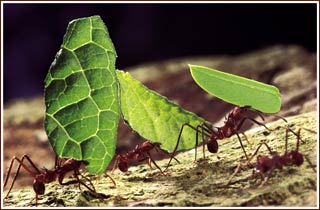Urban 'ants' suffer better heat
The heat of cities is changing the way it responds to the intense temperature of urban living ants, providing an overview of the impacts that global climate change can cause. according to an international team of scientists.
The city is 10 to 15 F hotter than the countryside, with asphalt roads and other features that absorb and retain more energy than natural landscapes. The researchers call this urban 'heat island' effect .
The researchers investigated leaf-eating ant colonies (scientific name Atta sexdens rubropilosa) inside and outside São Paulo, Brazil, South America's largest city with a population of more than 11 million. They focused on how well urban and rural ants suffer from extreme heat and cold in test chambers.
 (Photo: Doctorbugs) At 107.6 o F, scientists found that urban ants lasted 20% longer than living ants outside the city before being defeated by heat. very hot. Surprisingly, although the researchers think that extreme cold temperatures will defeat urban ants faster, they realize that ants living in urban areas recover as quickly as ants live outside the city when they kept in Petri dishes with ice.
(Photo: Doctorbugs) At 107.6 o F, scientists found that urban ants lasted 20% longer than living ants outside the city before being defeated by heat. very hot. Surprisingly, although the researchers think that extreme cold temperatures will defeat urban ants faster, they realize that ants living in urban areas recover as quickly as ants live outside the city when they kept in Petri dishes with ice.
'We do not know whether this model will be effective for other species or other cities, but people will have to pay attention to it,' said national university researcher Michael Angilletta. Indianna said in a prepared statement. 'Ultimately, this study can help us understand how animals will adapt to changes in global climate.'
'We will build a temperature map using satellite images recorded over several years'. Researcher Qihao Weng at Indiana National University said. 'These maps allow us to estimate the potential biological effects of urban warming and determine the appropriate location for future trials'.
Scientists published their findings in the February 28 issue of PLoS ONE
Ngoc Thanh
- Discover strange ants in the world
- Strange things about the ant world
- Weather forecast may be wrong for urban
- The secret of living ants is free in the Sahara desert
- Why ants 'dominate' the world
- Ant likes urban life
- This is what happens when an ant bites you, no wonder it hurts so much
- Video: The ants are robbing the eggs of the same kind to raise and make
- Mysterious ants 'click' midnight bell
- Ants have known 'cultivation' since ... 60 million years ago
- NASA scientific equipment draws heat maps from Europe from space
- Colonial colonial behavior changes after winning
 Why do potatoes have eyes?
Why do potatoes have eyes? 'Tragedy' the world's largest carnivorous life: Death becomes ... public toilet
'Tragedy' the world's largest carnivorous life: Death becomes ... public toilet Tomatoes were once considered 'poisonous' for 200 years
Tomatoes were once considered 'poisonous' for 200 years Detecting microscopic parasites on human face
Detecting microscopic parasites on human face